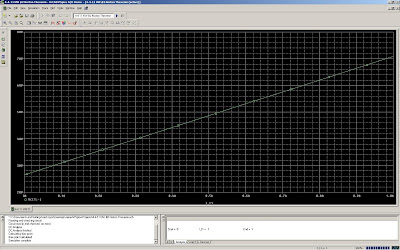For the first circuit, these were the values that I calculated using the equivalent resistance method and mesh analysis:
Vt = 43.07V
Rt = 7.47 kOhms
I drew up this circuit in PSpice, and just like with Wednesday's in-class work, I inserted a current source and swept it to find the Thevenin voltage. The y-intercept matched up with my 43.07V, and the slope was my 7.47 kOhms.
 | ||
| Click for larger |
I could predict Norton current using Ohm's Law:
In= Vth/Rth = 5.77mA
I replaced the current supply with a voltage supply in PSpice and did a sweep. The intercept is about 5.77mA:
 |
| Click for larger |
Finally, I used (Vth^2)/(4Rth) to predict that Pm = 62.08mW. This should occur when Rl=Rth. I drew up the equivalent circuit and swept the load resistor. The maximum on my graph was at f(7.47 kOhms)=62.08mW.
 |
| Click for larger |
I used the exact same method to compute Vth, Rth, In, and max power in PSpice for homework problem #2; all of my predicted values agreed with PSpice's.
 |
| HW #2 Vth/Rth (click for larger) |
 |
| HW #2 In (click for larger) |
 |
| HW #2 max power (click for larger) |
No comments:
Post a Comment